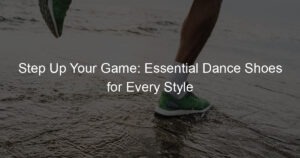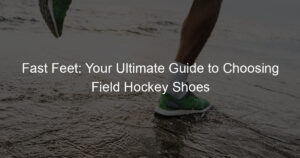When engaging in water activities, the type of footwear you choose can greatly impact your overall experience.
There are numerous options available, including Water Shoes vs. Barefoot vs. Regular Shoes.
Each choice has its own set of benefits and drawbacks to consider, making it essential to weigh your options before diving into your next aquatic adventure.
Water shoes are specifically designed for water-based activities, offering protection, grip, and quick-drying capabilities.
Going barefoot allows for a more natural connection with the environment and can provide sensory feedback that improves your balance. On the other hand, regular shoes can be cumbersome and slow to dry when submerged in water.
Ultimately, your choice of footwear will depend on factors such as the specific activity, your personal preferences, and the environment in which you’ll be participating.
Key Takeaways
- Footwear choices for water activities include water shoes, barefoot, and regular shoes, each with unique benefits and disadvantages.
- Factors to consider when choosing appropriate footwear include activity type, personal preferences, and environmental conditions.
- Material, safety features, comfort, and practicality are important aspects to keep in mind when evaluating footwear options for water activities.
Comparison of Water Shoes vs. Barefoot vs. Regular Shoes

When I consider water shoes, going barefoot, and regular shoes for water activities, I notice several differences between them. Water shoes are designed specifically for water activities, and they offer numerous advantages over other options.
They are lightweight, quick-drying, and provide good traction on wet surfaces. Some water shoes are even made with mesh or perforated fabric, which allows for ventilation and water drainage.
Going barefoot is a popular choice for many people during water activities, as it provides a natural, unrestricted feeling. However, it can be risky in terms of potential injury and lack of protection.
Sharp objects, rocks, and hot sand can harm the feet, and lack of support may become an issue when navigating rough terrain.
Lastly, regular shoes such as sneakers or running shoes are typically not the best option for water activities. While they may provide support and protection, they are not designed to be submerged in water.
They take a longer time to dry, become heavy when waterlogged, and can harbor bacteria or mold if not properly cleaned.
Here is a quick comparison of these three options for water activities:
| Feature | Water Shoes | Barefoot | Regular Shoes |
|---|---|---|---|
| Lightweight | Yes | Yes | No |
| Quick-drying | Yes | Yes | No |
| Traction | Good | Fair | Poor* |
| Support | Moderate | Minimal | Good |
| Protection | Moderate | None | Good |
*Assuming regular shoes aren’t specifically designed for water activities.
In terms of comfort, water shoes are hard to beat when engaging in water activities, as they’re designed with users’ comfort in mind. They often feature soft materials, adjustable straps, or elastic bands for a snug and secure fit.
On the other hand, going barefoot can be comfortable for some, but it ultimately depends on the person’s tolerance and the environment.
Barefoot shoes and barefoot water shoes are other alternative options to consider. They offer the flexibility and feeling of going barefoot while providing a minimal layer of protection and traction for the feet.
However, it is important to remember that they do not provide the same level of support as water shoes or regular shoes.
When choosing between water shoes, barefoot, and regular shoes for water activities, it is essential to weigh the pros and cons of each option.
Factors such as comfort, protection, support, and suitability for the activity should be considered to make an informed decision.
Water Activities and Appropriate Footwear
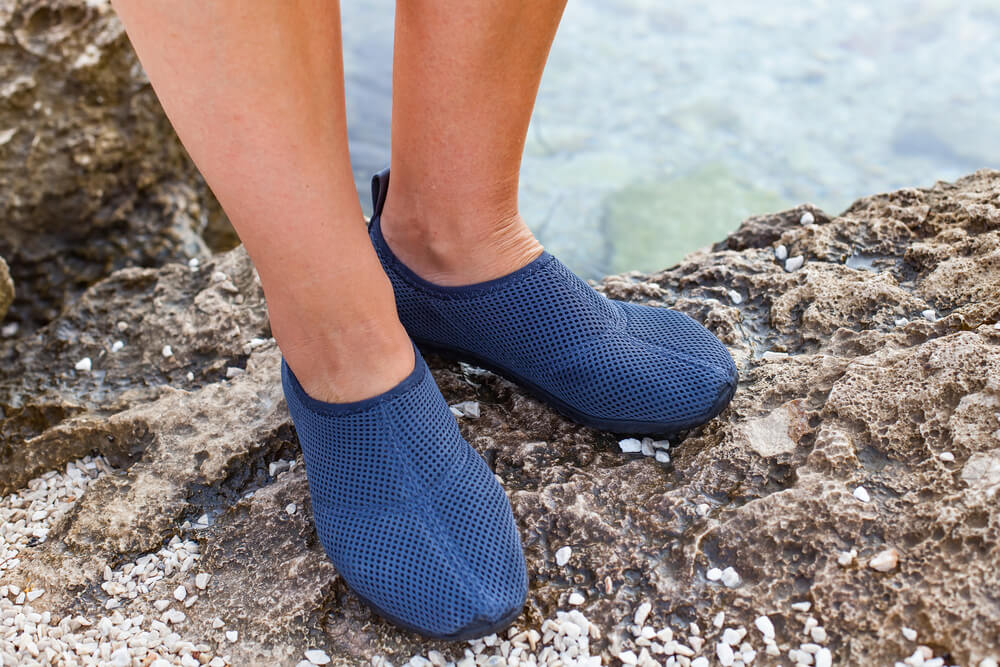
Swimming and Diving
When it comes to swimming and diving, my recommendation is to go barefoot. It’s the most natural and comfortable option. Using regular shoes is not practical, as they can weigh me down and become waterlogged.
Water shoes are suitable for protecting my feet from rocks and sharp shells, especially in shallow water, but they can also create drag.
Kayaking and Rafting
For kayaking and rafting, I find that water shoes are the best option. They provide excellent grip on slippery surfaces and are designed to drain water quickly.
Regular shoes can absorb water and become heavy, which is not ideal for these sports. Going barefoot offers some agility but sacrifices protection against rough surfaces, rocks, and wildlife.
Hiking and Trekking
When hiking and trekking alongside bodies of water or through streams, I recommend water shoes or specialized hiking sandals. They offer adequate support, traction, and quick-drying capabilities.
Using regular shoes can lead to discomfort as they don’t dry quickly, and going barefoot can result in injury from uneven terrain and potential hazards.
Fishing
Fishing may require different types of footwear, depending on the environment. When I’m fishing on a boat or from a dock, I prefer water shoes for their grip and overall comfort.
Nevertheless, if I’m wading in the water, I may opt for wading boots or waders, which provide extra support and insulation. Going barefoot is not recommended while fishing due to potential hazards, such as hooks or sharp rocks.
Surfing and Paddleboarding
For surfing and paddleboarding, I generally go barefoot because it offers the most natural feeling and control over the board. Water shoes can be suitable for added foot protection but might hinder board control.
Regular shoes are not practical for these sports, as they can easily slip off and become waterlogged.
Material Analysis
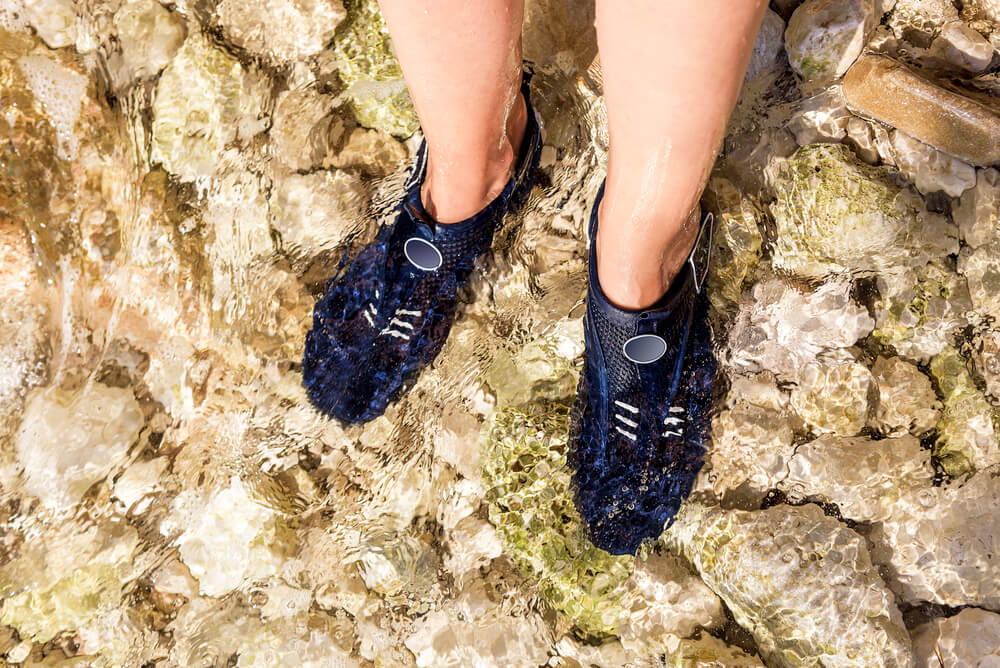
Rubber
Rubber is a popular choice for water shoes because it offers excellent grip, durability, and water resistance. I’ve found that rubber-soled water shoes are particularly suitable for activities like kayaking, paddle boarding, and fishing, where having a stable footing is essential.
One downside to rubber, however, is that it can be less flexible and heavier than some other materials.
Mesh
Mesh is a common material used for the upper part of water shoes, providing breathability, quick-drying capabilities, and lightweight comfort.
I’ve noted that mesh upper water shoes are great for general water activities like swimming, snorkeling, and beach volleyball.
Yet, the open structure of mesh may not offer as much protection against sharp rocks, debris, or hot surfaces compared to more solid materials.
Neoprene
Neoprene is a synthetic rubber that provides good insulation, water resistance, and flexibility. It is often used in wetsuits and water shoes, making them suitable for colder water.
I appreciate that neoprene water shoes are perfect for activities like diving, surfing, and other intense water sports since they provide excellent grip and cushioning while staying comfortable and snug.
Fabric
Fabric materials, such as polyester and nylon, can also be used for lightweight and breathable water shoes. These are ideal for casual water activities, like playing at the beach or lounging by the pool.
Regardless, I’ve discovered that fabric water shoes may not offer the same level of durability and protection as other materials, making them less suitable for intense or rocky environments.
Plastic
Plastic materials, such as EVA and PVC, can be used for water shoes’ soles and uppers. These materials are water-resistant, lightweight, and sometimes offer better support and protection than more flexible materials like mesh or fabric.
Plastic water shoes may not be as comfortable or breathable as other options.
Canvas
Canvas is a sturdy, durable fabric often used for casual sneakers and can be incorporated into water shoes as well. Canvas upper water shoes provide more foot protection than mesh but might not dry as quickly.
I have found that canvas water shoes perform well for light-water-based activities like boating, but they aren’t as well-suited for intensive water sports or extended periods in the water.
Safety and Protection Features
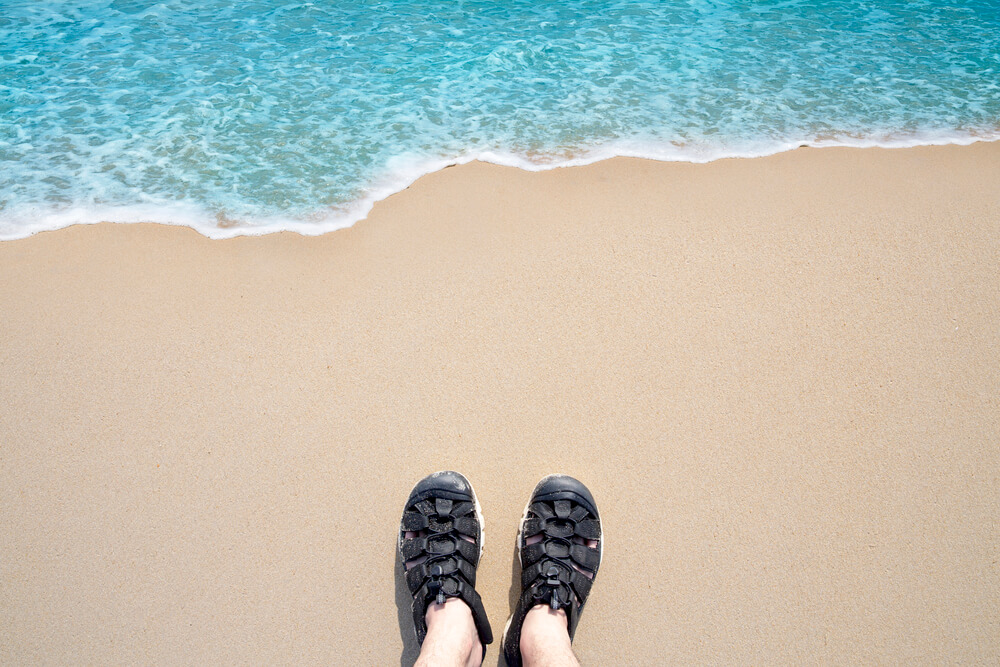
When it comes to safety and protection features, water shoes, barefoot, and regular shoes have their unique strengths and weaknesses.
For water shoes, the primary advantage is the added protection they offer. Made from durable materials like neoprene and mesh, water shoes shield my feet from rocks, debris, and sharp objects that I might encounter while participating in water activities.
The sturdy rubber soles provide enhanced traction and grip on slippery surfaces, reducing the likelihood of slipping and getting injured.
Moreover, they offer ample support for my feet, safeguarding my toes and arches during various water sports.
On the other hand, going barefoot allows me to have a more natural connection with the environment. Although minimal, the skin on my feet can still provide a degree of traction and grip on wet surfaces.
This option poses a higher risk for cuts, blisters, and injuries due to the lack of protection against sharp objects, rough terrain, and other hazards.
It’s important to note that being barefoot might not be suitable for all situations and could increase the chances of injury.
Lastly, regular shoes, while offering adequate support and protection for everyday activities, are not designed explicitly for water environments.
The materials used in standard shoes can become waterlogged, affecting their grip and traction on wet surfaces. This can lead to a higher risk of slipping and accidents.
Furthermore, regular shoes are not crafted to protect my feet from punctures and cuts caused by hidden sharp objects in water environments.
Each option has its pros and cons when considering safety and protection features for water activities. Water shoes stand out as the best choice for most situations, given their specialized design for water-based environments.
Both the barefoot and regular shoe options have their specific use cases, but they lack the same level of protection and support provided by water shoes.
Comfort and Fit

When it comes to water activities, I find that comfort and fit play a significant role in choosing the right footwear.
In my experience, water shoes, barefoot, and regular shoes have distinct features that affect comfort, weight, size, cushioning, breathability, and chafing.
Water shoes are designed for water activities, which means they prioritize comfort and functionality in wet conditions. The lightweight water shoes are ideal for activities such as kayaking, paddleboarding, and beachcombing, as they reduce fatigue.
The snug fit of water shoes prevents water from entering, reducing chafing and discomfort while keeping your feet warmer. Also, water shoes often have better cushioning and breathability than regular shoes.
On the other hand, going barefoot is the most natural way to enjoy water activities. There’s no weight on your feet, which can make it very comfortable for activities like swimming and wading in shallow waters.
Nonetheless, the lack of cushioning and protection might cause discomfort when walking on rocky surfaces or hot sand. One thing to note is that breathability and chafing are not concerns when going barefoot.
Lastly, I’ve tried using regular shoes during water activities, and they’re not the best choice. When they’re exposed to water, they become heavy and can cause chafing due to the excess moisture.
They might also lack the proper cushioning and grip for activities in wet environments. Furthermore, regular shoes often take a long time to dry and can develop unpleasant odors.
Each footwear option has its pros and cons for water activities. Water shoes provide the best combination of comfort, fit, and protection while going barefoot offers weightlessness and a more natural experience.
Regular shoes have limitations in wet environments but could be suitable in some situations.
Advantages of Going Barefoot

I find that going barefoot brings numerous benefits during various water activities. First and foremost, walking or swimming without shoes allows me to have a direct connection with the environment.
I can feel the texture of the ocean floor, the warmth of the sand, or the coolness of the water – all adding to my sense of freedom and relaxation.
Moreover, when I am in natural environments, going barefoot helps me minimize the impact of my activities on the ecosystem.
For many individuals, including myself, being barefoot can be more comfortable than wearing shoes. I often find that shoes, even water shoes, can cause skin irritation and discomfort after prolonged use.
Regardless, when I am barefoot, my feet can breathe, allowing me to fully enjoy my water adventures. I can quickly and easily transition from swimming to walking, unrestricted by the need to remove or put on footwear.
I have also noticed that when I go barefoot, my feet maintain their natural function and mobility. Engaging in water activities without shoes helps me develop and maintain foot strength, balance, and coordination.
Moreover, it assists me in honing my proprioception and the ability to sense the position and movement of my body, which is crucial when navigating through slippery or uneven terrains.
Going barefoot presents several advantages during water activities – offering a closer connection to the environment, enhancing comfort, and supporting the natural functions of my feet.
I highly recommend experiencing water adventures without shoes for a more enjoyable and enriching experience.
Special Features
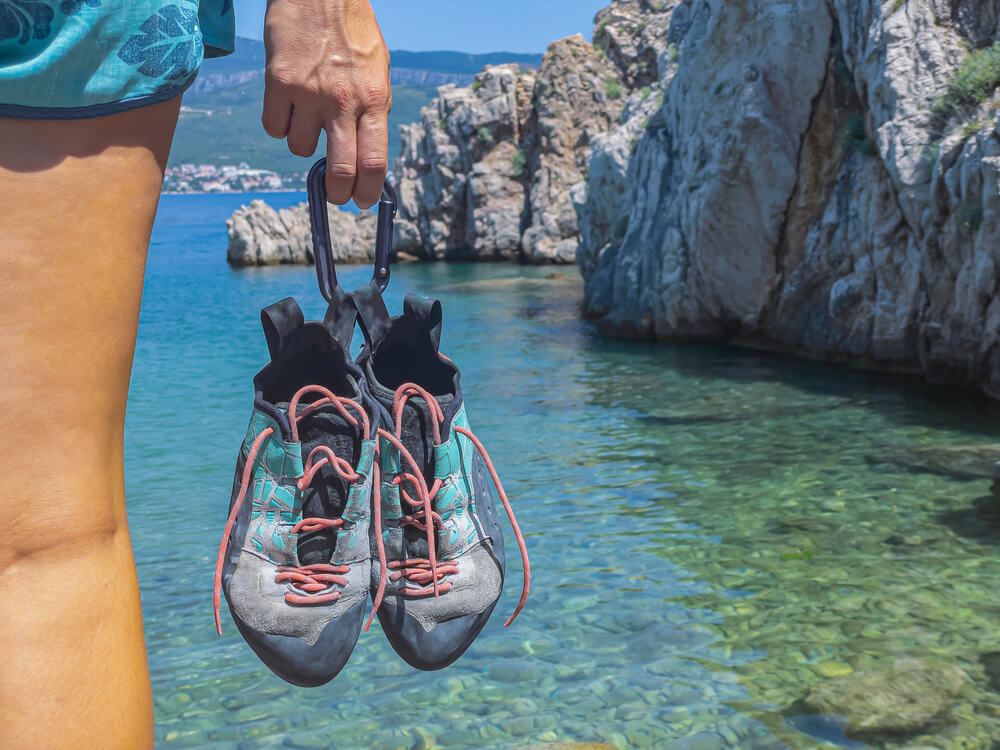
Drainage Holes
One of the main advantages of water shoes is that they typically have drainage holes that allow water to flow in and out of the shoe.
When I’m walking in wet conditions or participating in water activities, drainage holes prevent my shoes from retaining water and becoming heavy or waterlogged.
This design also helps to avoid the discomfort of squelching water in my shoes as I walk.
Quick Drying
Another noteworthy feature of water shoes is their quick-drying material, which helps minimize the time it takes for the shoe to dry after getting wet.
Since water activities often involve both water and land, having a shoe that dries quickly lets me transition smoothly between different environments without worry.
Additionally, quick-drying shoes can help reduce the risks of slipping or developing odors and mildew.
Aqua Socks
A variation of water shoes is the aqua sock, which is essentially a thin, slip-on shoe designed for activities in and around water. Aqua socks offer protection and comfort, especially when walking on rocky or uneven surfaces in water.
While they may not provide the same level of support that other water shoes do, they do deliver a lightweight and flexible experience. I find aqua socks particularly useful for activities like paddleboarding or kayaking when I need more dexterity on my feet.
Strap
Finally, many water shoes are equipped with a strap to secure the shoe onto my foot, ensuring that it won’t come off during water activities.
The strap can be adjustable for a custom fit, allowing me to create the ideal level of tightness and comfort for my foot.
This minimizes the chance of losing my shoe while participating in water sports and also contributes to better overall stability and support as I move.
Durability and Price Analysis
In my experience, the durability and price of water shoes, regular shoes, and going barefoot for water activities can vary greatly.
I’ll provide a brief analysis of each option when we consider durability, price, affordability, and value.
Water Shoes: Water shoes are specifically designed for water activities, so their durability tends to be better for such environments. They are made from water-resistant materials that help protect your feet from sharp objects, and they dry quickly. Price-wise, water shoes can be found in a wide range, from very affordable to high-end models. In terms of value, I believe this is a good investment if you regularly participate in water activities.
Barefoot: There is no cost associated with going barefoot, making it the most affordable option. However, walking barefoot on wet surfaces increases the risk of slipping and injuries from sharp objects. It is also less durable as your feet are directly exposed to harsh elements. While you may not be spending money on footwear, the potential costs of medical treatments for injuries should be taken into account.
Regular Shoes: While some regular shoes can be worn during water activities, they are not specifically designed for this purpose. As a result, their durability may be compromised. They can absorb water, become heavy, and take longer to dry. In terms of price, regular shoes also have a wide range, from budget-friendly to expensive. However, their value for water activities is lower because they were not designed with those conditions in mind.
To sum it up, water shoes offer the best balance of durability, price, and value for water activities, while going barefoot can be an affordable but less durable option. Regular shoes can be used, but their performance in water activities may not justify the cost.
It’s important to weigh these factors when choosing the most suitable footwear for your needs.
Footwear and Environmental Impact
In my experience with water activities, I have observed that choosing the right footwear can have a significant impact on the environment.
When considering water shoes, barefoot, and regular shoes, I believe that each has its advantages and disadvantages concerning different environments.
When I visit environments with slippery surfaces, rocks, or hot sand, water shoes have proven to be my best choice. The non-slip soles and toe protection they offer provide stability and safety on such unstable terrains.
Plus, they can help to reduce the number of accidents and, more importantly, minimize the damage to these delicate ecosystems.
Conversely, going barefoot offers the most natural approach when it comes to experiencing various water activities. As a result, I feel more connected to my surroundings and tread lightly on land, reducing my impact on the environment.
Yet, going barefoot also leaves my feet vulnerable to injury on rough or rocky terrain.
On the other hand, wearing regular shoes during water activities can lead to unintended consequences. While they may provide more significant protection on dry land, they are not suitable for wet environments such as rocky shorelines and rivers.
I have found that regular shoes can become waterlogged and heavy, causing reduced mobility and potential damage to the environment.
When navigating through different environments, it’s crucial to consider the potential effects of my choice of footwear on the land.
Whether I am crossing a rocky shoreline or traversing hot sand, keeping in mind the connections between myself, the environment, and the footwear I choose can help promote a more sustainable approach to enjoying water activities.
Practicality and Aesthetics
When considering water shoes, barefoot, and regular shoes for water activities, practicality and aesthetics play an important role in my decision.
As a sports enthusiast, I’m always looking for the best options for different water activities.
Water shoes are the most practical choice for various water sports. These shoes offer protection, comfort, and traction. The design of water shoes allows me to navigate slippery surfaces and sharp objects without compromising my safety.
However, when it comes to fashion and aesthetics, water shoes often fall short. The designs can look bulky and less stylish compared to other footwear options like sandals and flip-flops.
As a fashion-conscious person, I love the aesthetics offered by sandals and flip-flops. These options can be both stylish and functional, especially for casual water activities.
They allow my feet to breathe and dry quickly. Nonetheless, sandals and flip-flops may not be suitable for strenuous water sports as they lack proper support and protection.
Going barefoot is the most liberating sensation for me during water activities. It provides a connection to nature and freedom of movement that no footwear can replicate.
For certain water sports like beach volleyball or paddleboarding, going barefoot can even be quite practical. However, I must be cautious about the terrain and potential hazards that may be present on the water or beach.
Each option has its own set of practical and aesthetic factors to consider when choosing footwear for water activities.
Water shoes provide the best protection and support for intense water sports, while sandals and flip-flops offer a stylish and breathable choice for more casual activities.
Ultimately, going barefoot is the most natural feeling but may not be suitable for all situations or sports.
Performance and Versatility
When it comes to water activities, choosing the right footwear can greatly impact your performance and the versatility of your experience.
As someone who loves water sports and outdoor activities, I’ve had my fair share of experiences with various types of footwear.
Water shoes offer excellent performance in terms of flexibility, as they are designed to be light and elastic. This allows me to easily adapt to different terrains, whether it be rocky shores or slippery surfaces.
The soles of water shoes provide stability and grip, which helps me to avoid slipping and maintain balance during various water-based activities.
On the other hand, going barefoot offers unmatched flexibility, allowing my feet to naturally adjust to different surfaces and movements.
However, this comes at the cost of reduced protection and stability. My feet are more vulnerable to cuts and injuries from sharp rocks or debris, and maintaining balance can be challenging, especially on slippery surfaces.
Regular shoes, while offering more protection and stability than going barefoot, tend to be less flexible than water shoes. Although some regular shoes offer decent traction, they often lack the specialized designs that make water shoes versatile for different terrains and activities in wet environments.
Furthermore, regular shoes can become waterlogged, making them heavy and less comfortable during prolonged water activities.
In terms of versatility, water shoes hold an advantage over both barefoot and regular shoes. As a water sports enthusiast, I find that water shoes allow me to participate in a wide range of activities, from kayaking and paddleboarding to beach volleyball and hiking along wet trails.
Their specialized design provides a combination of flexibility, stability, and protection that can’t be matched by going barefoot or wearing regular shoes.
By considering performance, flexibility, stability, and versatility, it’s clear that water shoes offer significant benefits for various water activities compared to going barefoot or wearing regular shoes.
As someone who enjoys maximizing my experiences in water sports and outdoor activities, I find that water shoes are an indispensable part of my gear collection.
Hygiene and Health Risks
When comparing water shoes, going barefoot, and wearing regular shoes for water activities, it’s essential to consider the hygiene and health risks involved.
As someone who engages in water activities, I have observed how different footwear impacts hygiene and health risks.
Wearing water shoes, in my experience, is the most hygienic option. These shoes are designed to keep your feet protected from harmful elements, such as sharp objects and parasites that may be present in the water.
They also fit snugly, which helps prevent debris from entering and causing discomfort or infection.
Going barefoot, on the other hand, exposes your feet directly to potential hazards, making them more prone to cuts, abrasions, or the entry of parasites.
While this option allows for a more natural feel, hygiene becomes a concern, as you may not be able to thoroughly clean your feet after every water activity.
Regular shoes should not be worn during water activities, as they are not designed for water exposure. They can become waterlogged, heavy, and uncomfortable.
More importantly, they create a breeding ground for bacteria, fungus, and other germs due to dampness and can lead to foot infections.
Water shoes offer the best protection against hygiene and health risks, while going barefoot leaves you more vulnerable, and wearing regular shoes can increase the risk of infections.
Conclusion
When it comes to water activities, I find that the choice between water shoes, going barefoot, and regular shoes greatly depends on the activity itself and personal preferences.
Each option has its unique characteristics, and understanding the advantages and disadvantages of each can help you make an informed decision.
For fitness enthusiasts, water shoes can be a game-changer. They provide solid soles and an upper part with a minimalist design that makes exercising in water comfortable and efficient.
The Xtratuf Riptide, for example, offers excellent grip and support during activities like water aerobics or aqua jogging.
Barefoot enthusiasts might argue that the most natural way to enjoy water activities is without shoes. Walking in water can have a lower impact on joints, which can be beneficial for some.
Nevertheless, going barefoot might not be the best choice for those who participate in high-intensity activities such as whitewater sports or rocky coastal hikes, as there is a higher risk of injury.
On the other hand, regular shoes might not be ideal for water activities at all. Their materials may become waterlogged and heavy, making them uncomfortable and inefficient for water-based sports.
Likewise, regular shoes can also be more challenging to dry and maintain after getting wet.
In conclusion, it is essential to consider the specific activity, the potential risks, and personal preferences when choosing between water shoes, going barefoot, or wearing regular shoes for water sports.
By taking all factors into account, you can confidently make the best decision that suits your needs and enhances your water activities experience.
Frequently Asked Questions
What are the advantages of water shoes vs. regular shoes for water activities?
In my experience, water shoes offer several advantages over regular shoes for water activities. They typically have quick-drying materials, which prevent the buildup of uncomfortable moisture.
The soles are usually made from a non-slip material like rubber, enhancing grip on slippery surfaces. Additionally, water shoes support and protect feet during various activities like swimming, boating, or beach volleyball.
Can water shoes be used for running in and out of water?
Yes, water shoes are designed for running both in and out of water. They have features such as drainage holes and quick-drying materials that provide comfort and support when transitioning between wet and dry environments.
Their durable soles offer adequate traction on different surfaces, making them suitable for various terrains.
How do barefoot water shoes compare to regular water shoes?
Barefoot water shoes, also known as minimalist shoes, aim to mimic the sensation of walking or running barefoot while still providing some protection for your feet.
These shoes tend to have thin, flexible soles, which allow your feet to have more direct contact with the ground and move more naturally.
In comparison, regular water shoes typically have thicker soles for added protection and support, making them less flexible.
What are the key features to look for in a good water shoe?
When selecting a water shoe, I consider several key features. First, choose a shoe made from quick-drying materials to prevent discomfort and blisters.
The sole should be non-slip and provide enough traction for various surfaces. Look for shoes with breathable mesh or drainage holes that assist in water drainage and airflow.
Finally, consider the fit, as a secure yet comfortable fit ensures stability during a range of activities.
Are water shoes versatile enough for various water activities?
I find water shoes to be quite versatile, as they are suitable for many water activities such as swimming, kayaking, stand-up paddleboarding, and snorkeling. They can also be used for aquatic fitness classes or beach sports.
However, water shoes may not be suitable for more specialized activities that require specific footwear, such as diving or water skiing.
How do barefoot water shoes affect performance while swimming?
Barefoot water shoes can be a great option for swimming if you’re looking for minimal foot protection without hindering your performance. Their thin soles allow for flexibility and natural movement, which can improve your swimming technique by letting your feet move freely.
However, barefoot water shoes may not provide as much support and protection as more traditional water shoes, so consider your specific needs and preferences before choosing this option.




